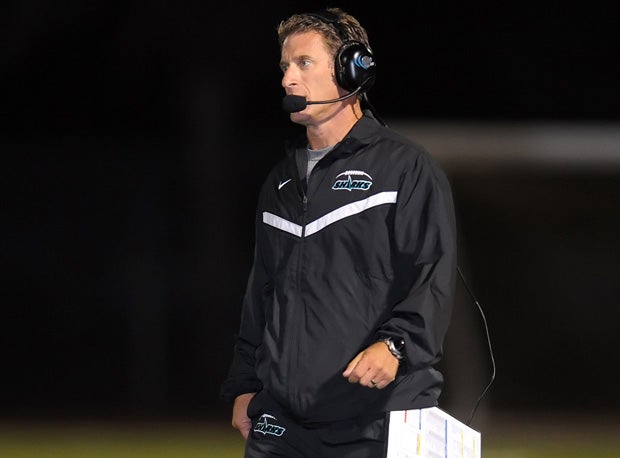Video: Recap - Randolph vs. Ardmore 2016
See the Randolph Academy defense in action this past season.USC head coach Clay Helton put an emphasis on turnovers in 2016, his first season leading the Trojans. Early on in camp, he started telling his team to "bring me three balls per game."
That was the goal he laid out for the defense: three turnovers forced per game. Well, they took it literally. Early in the season, those who ended up with a fumble recovery or interception literally ran the ball to their proud head coach, sometimes irking officials who were asking for the ball. Helton loved those gifts.
Turnovers can change a game. They can change a season. Some programs put a premium on turnovers, and the proof is on the field. The results show their programs in the "plus" category at the end of the season.
Jeff Steinberg, head coach at
Rancho Verde (Moreno Valley, Calif.), is one of those coaches who places a high value on creating a culture of turnover awareness. He took over at Rancho Verde in 2015. They forced 19 turnovers in his first season (10 interceptions and nine fumble recoveries). This year, after touting more of an emphasis on turnovers, they increased turnovers by an astounding 126 percent in just one year. They had 43 takeaways in 2016: 21 interceptions and 22 fumble recoveries.
Steinberg told me that "We work it every single day and it is encouraged in all periods. It all starts with pursuit. Our first defensive drill of the year was a pursuit drill. If 11 guys are getting to the ball, then good things will happen. We also included it into our weekly game goals. Obviously we want to win each game but we believe if we focus on game goals then winning will be a byproduct. We talk about taking care of the ball on offense and taking it away on defense. When we weren't doing a turnover circuit it was incorporated into individual drills on defense and encouraged during group and team periods."

Coach Jeff Steinberg from his days at Santiago (Corona, Calif.).
File photo by David Hood
Steinberg's turnover circuit consists of: 1. Scoop and score; 2. Club, punch and rip; 3. First man tackle through the ball, second man work ball out, and 4. Interception and convoy.
Another coach does a similar circuit, but not exactly.
Blake Killen is the defensive coordinator at
Randolph School (Huntsville, Ala.). I saw a stat online about his program that intrigued me: They had NINE turnovers in one game! After winning just 11 games in the previous four years before Killen came on board, Randolph School has qualified for the playoffs in each of the last two seasons, in part due to turnovers forced. They had 31 turnovers in Killen's first year -14 of those interceptions, a school record.
Taking the ball away from your opponent 31 times during the season will have a dramatic impact on points allowed. At Randolph School, they cut points allowed per game from 29.4 in 2014 to 18.9 in 2016. That is a big difference in defensive football in just two seasons.
When I asked about what they do that results in the turnovers, Killen explained a turnover circuit that they do twice a week.
"We emphasize stripping the ball, creating interceptions and recovering fumbles. We preach every week that we want three turnovers a game (Same as USC). We preach that turnovers are created by being extremely physical and by having 11 guys around the football."
Here is Killen's turnover circuit:
We will have four stations, each one involves a different drill/skill. The total circuit lasts for eight minutes, with each station being two minutes long. Players go through the drills with their defensive position groups. The format of the circuit is the same every day, but we will mix up the drills.
Tip Drill: Players are in a straight line. They run two at a time. The first player wants to bat the ball into the air as high as he can and the second player will jump and catch the ball at its highest point.
Scoop and Score: Players are in a straight line facing a coach. The coach will roll the ball out in front of the players. They will scoop it up with knuckles in the grass, and then sprint 10 yards.
Strip Drill: Players are partnered up. One partner is carrying the ball high and tight and jogging for 10 yards. The defensive player is right beside him. He tries to violently rip it out with one hand while securing the tackle with the other hand.
Punch Drill: Same as above but now the defensive player is behind the ballcarrier and is violently punching the ball out. We want a violent uppercut.
Sack Fumble: A coach is in a passing stance with the ball up around his ear, like he is about to throw it. The defender comes in and secures the tackle with one hand and rakes down through the coach's throwing hand to cause a fumble with the other hand.
Interception Drill: Players are in two lines facing a coach. One line is five yards in front of the other. The first line is standing still and showing the coach their hands. The coach will give the cadence and then try to complete the pass to the first player. The second player breaks downhill through the receiver's shoulder to intercept the pass. He will sprint 10 yards to simulate a score.
Combo Strip: There will be one ballcarrier and two defenders. One defender is setting the ballcarrier up for a tackle and the other defender is ripping the ball out.
Chris Fore is a veteran Head Football Coach and Athletic Director from Southern California. He consults coaches and programs nationwide through his business Eight Laces Consulting.
